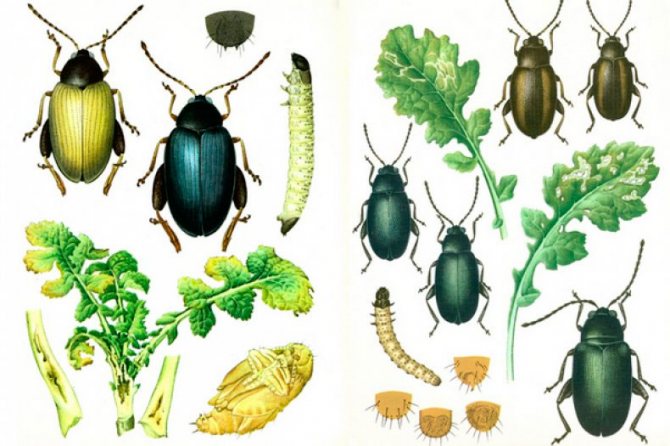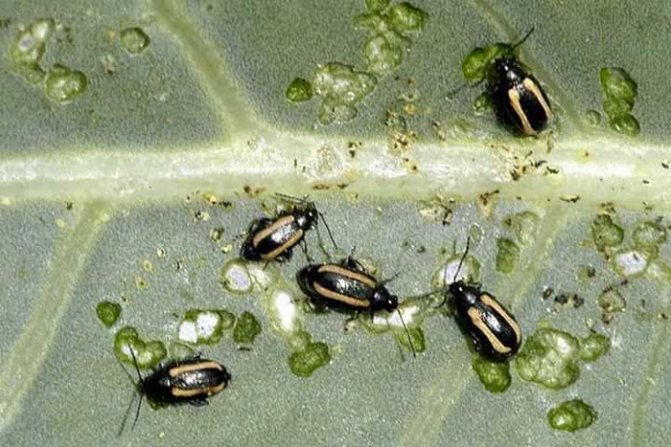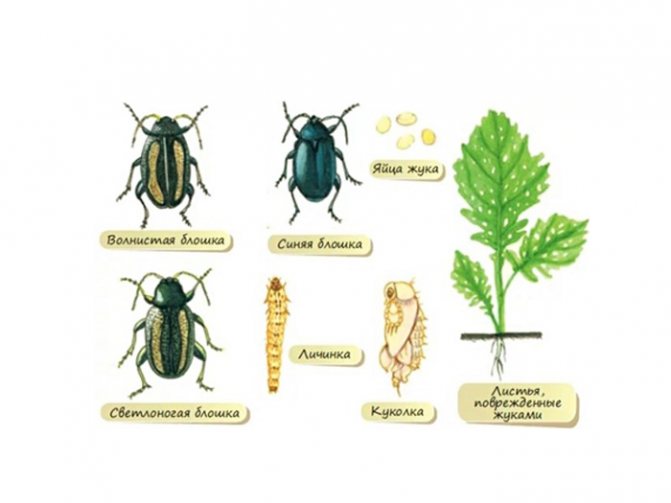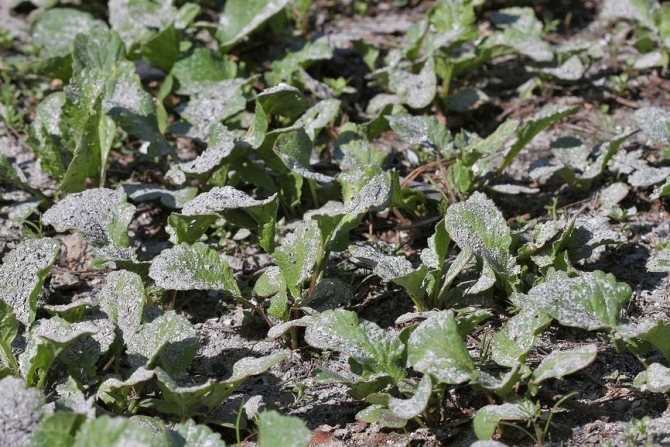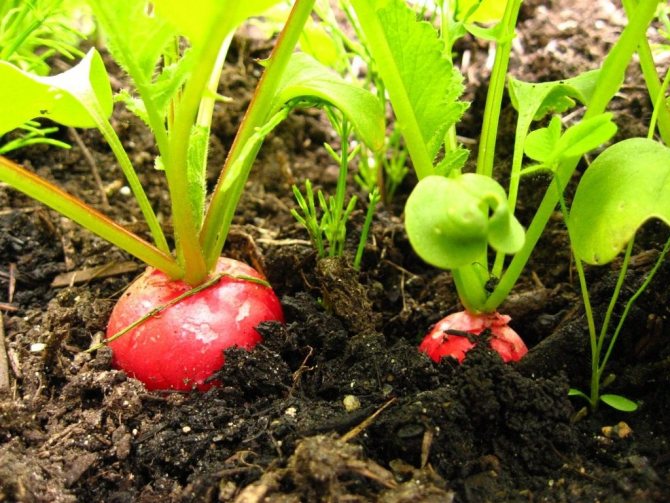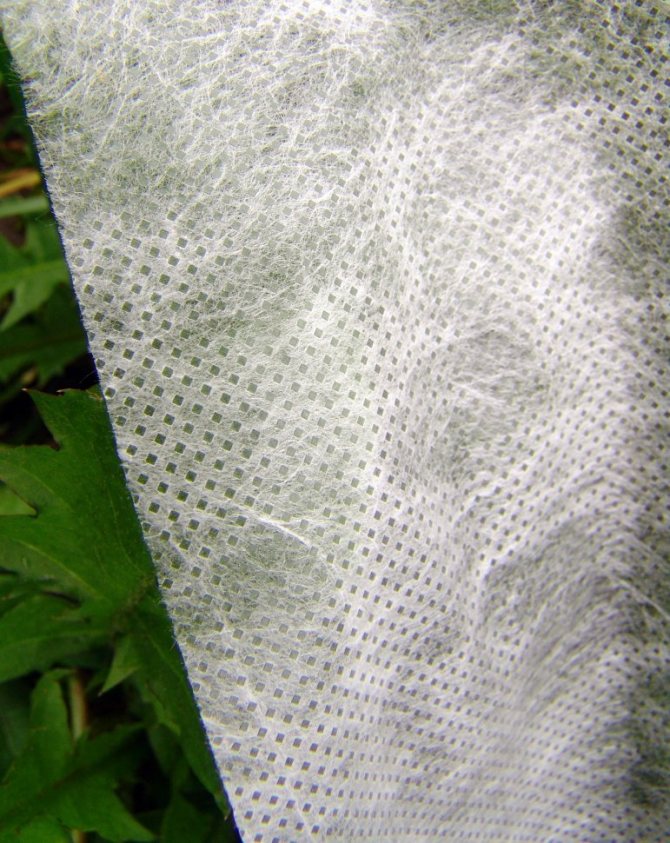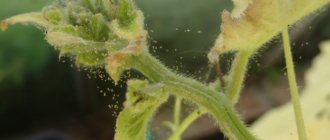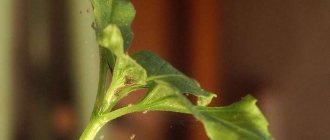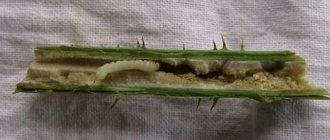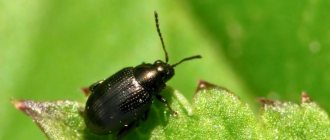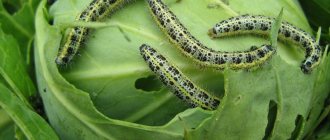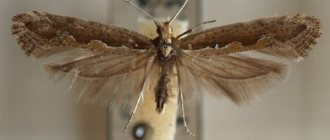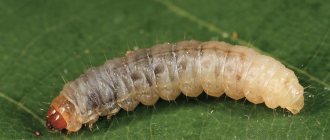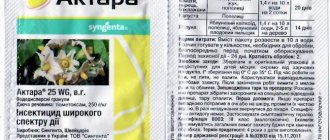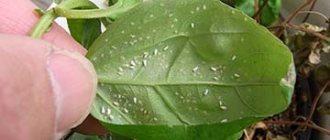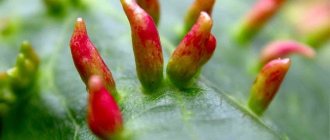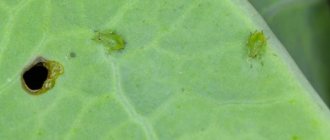Insect cruciferous flea, or cabbage (Latin Phyllotreta crusiferae) represents a species of earthen flea beetles of the Kozyavok subfamily of the leaf beetle family. It is found in the Mediterranean region, Europe, the Caucasus, Turkey and Central Asia. Both the adult cabbage flea and its larvae feed on the leaves of plants of the Cruciferous family, or Cabbage - rape, radish, radish, horseradish, daikon, turnip, swede and all types of cabbage.
Flea on cabbage: control measures and folk remedies

Growing cabbage, vegetable growers often notice that dots and small holes are formed on the leaves. The sight is rather sad, especially considering that damaged bushes are more susceptible to infections than others. Ragged leaf plates are the work of a small pest. The cruciferous flea beetle is quite common on cabbage, because the tiny bug feeds on the juice of the culture. Even experienced vegetable growers can not always quickly get rid of insects that attacked the garden. Getting to know the pest and its lifestyle will help protect the cabbage from black bugs.
Flea on a cabbage leaf
Winter scoops
Someone thinks that winter moths are small fleas. In fact, this is the name of the caterpillars, which cause serious diseases that kill eggplants.
Winter scoops attack a vegetable plant when it does not yet have time to get strong. Seedlings are highly vulnerable to this pest. Damaged eggplants easily pick up diseases that prevent them from developing and ripening.
The caterpillars of the winter scoop can destroy the bush in a couple of days.
This insect eats a young stem - one of the most important organs of any plant.
To cope with such a pest, it is necessary to cultivate the soil around the beds, loosen it well so that the summer resident can destroy the places where winter scoops sit in the daytime. You can also fight by weeding. These measures will be enough for the insect that eats young seedlings to disappear from the garden for a long time.
Description of the cruciferous flea
The little black jumping bugs on cabbage are cruciferous fleas. This name was given to them because plants from the Cruciferous family predominate in the diet of insects. Pests hibernate in plant debris in the plots and in the upper soil layer. In early spring, when the air temperature rises to + 14 ... + 16 degrees, they wake up and begin to act. At first, weeds serve as food for them, but as soon as cabbage seedlings appear in the garden, insects attack it and other cultivated plants.
The body length of the cruciferous flea varies from 3-4 mm, and the color is different, depending on the type of leaf beetle:
Insects are equipped with hock hind legs. Adults feed on the aboveground part of plants, they scrape off a thin surface layer of leaf plates. The larvae of the cruciferous wavy flea beetle eat the young roots of the seedlings.
Attention! Other plants also suffer from insect attacks - horseradish, turnips, turnips, as well as flowers - roses, chrysanthemums and levkoi.
Insect damage
Small black insects have one distinguishing property: they can jump high and far thanks to their developed hind legs.Adults of the flea, settling on the leaves of eggplant, begin to actively feed on them, gnawing through holes in the pulp of the leaf.
A large number of insects in a short time are able to completely skeleton the leaves, leaving only veins - to prevent such an outcome, you need to know how to deal with the pest and start activities in a timely manner.
Speaking about the harmfulness of the cruciferous flea, mention should be made of its larvae: hatching from eggs laid in the ground, the larvae live in it and harm the roots of plantations, gnawing them.
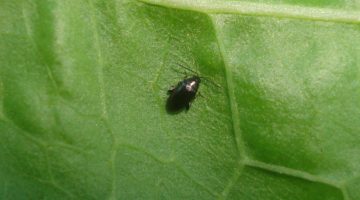

Although the pests usually like to settle on cruciferous plants, in some cases they also prefer other crops on the site, including nightshades and, in particular, eggplants. To protect them at the first appearance of enemy individuals, dusting and spraying are used.
- If there are few individuals on the plant, you can use folk remedies: spraying with infusion of dandelion, tomato tops or garlic is carried out regularly every 4-5 days. At the same time, you can add shavings of laundry soap to the composition so that the odorous liquid adheres better to the foliage.
- To treat flea plant beds, you can dilute 70% table vinegar (1 tsp) in water (10 L). All terrestrial parts of vegetation are treated with this solution.
- In order to expel the enemy from the beds, you can sprinkle the soil between the rows with tobacco dust or ash every 4-5 days. By the way, ash is also used for spraying the leaves, while it is added to the soap solution.
If the pests continue to bother the eggplants, and their number is only increasing, you can try mechanical catching of flea bees using sticky traps placed between the plantings. It is worth noting that fleas do not tolerate moisture well, so watering the plants should be regular.
Experienced experts to protect eggplants from cruciferous fleas recommend planting fungicidal vegetation next to them that repels pests - tomatoes, dill, coriander, calendula, as well as nasturtium. Be sure to adhere to the rules of crop rotation and often loosen the land near the plants.
Eggplants, like other popular crops, are not able to resist the attack of harmful insects that constantly annoy them. Plants themselves are unable to cope with such a misfortune. Therefore, they need help, which the gardener must certainly provide. In gratitude for the efforts, eggplants will delight you with a rich harvest.
It is difficult to grow healthy eggplants - pests love them very much
There is no one way that can solve the problem of insects that adversely affect the condition of vegetables. For each specific pest, you need to look for your own method, thanks to which the fight against it will be effective.
There are several types of insects that feel great in eggplant beds. They find a specific approach that helps the summer resident to forget about such a problem as eggplant pests for a long time.
Signs of a flea invasion on cabbage
It is easy to recognize the presence of intruders in a cabbage patch - just look at the plants. Fleas leave behind small holes in the leaves, the plants are literally riddled. The area around the sites of damage turns yellow. When the root system is damaged by the larvae, the plants lose their turgor and wither. The flea beetles themselves can be seen with the naked eye. If you touch the bush, they will start jumping. This is the main distinguishing feature of pests.
What cruciferous fleas look like
Having discovered the first signs of damage to the plantings by cruciferous flea beetles, do not hesitate. It is important to start fighting with them as quickly as possible, until their colonies have spread throughout the entire site.
Reference. These insects reproduce intensively in dry and hot weather.In one warm season, they produce 3 generations.
Reasons for the appearance
Cruciferous fleas live in winter in the upper layers of the soil or under plant debris. When spring comes and the ambient temperature rises above 15 ° C, fleas emerge from their hibernation shelters. If the time of planting the crop coincides with the time of emergence from hibernation, then the insect will feed on young foliage.
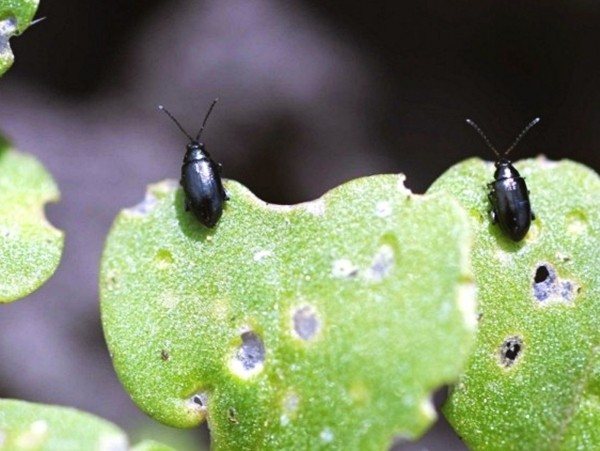

Another reason for the appearance of insects on seedlings can be considered a large number of weeds and plants belonging to the cruciferous. Their abundance near the future location of the seedlings affects the fact that the cruciferous flea has a food source and they can develop.
The appearance of leaf beetles is influenced by soil moisture indicators. The cruciferous flea is an insect that does not tolerate moisture well. In dry and hot weather, the flea grows actively. If you do a little watering or plant crops on soil with low moisture, you can find an increase in the invasion of flea beetles.
Methods for dealing with cruciferous flea beetles on cabbage
There are several ways to control pests. In regions where summer is very hot, gardeners immediately after planting seedlings in open ground cover the cabbage with a special net. This is one of the most reliable ways to protect against insects.
Other methods to help get rid of the cruciferous flea:
- Folk remedies - it is better to use them at the initial stage of the growing season to prevent insect infestations.
- Biological insecticides. Preparations with a low level of toxicity based on soil bacteria.
- Chemicals. They help to quickly destroy pests, but are harmful to people, birds, animals and pollinating insects.
Folk remedies against cruciferous fleas
Immediately after planting seedlings in the garden, you need to take care of protecting the plants from insects. Small jumping bugs do not settle on beds powdered with wood ash. It makes sense to take advantage of this and after the end of planting work, scatter a small amount of ash around the stems.
Attention! Ash is added to each hole when planting cabbage for the same purpose - to repel pests.
Young seedlings immediately attract the attention of fleas, so it is important to process the bushes themselves. Gardeners mix oven ash with fluff lime in equal parts, fill a gauze bag with a loose substance and dust the plantings with it. Instead of lime, you can take tobacco dust.
Folk remedies for flea beetles on cabbage include liquid formulations for spraying. How to process cabbage from fleas, recipes:
- Ash and soap solution. To prepare it, you will need a liter can of ash. It is poured with 3 liters of boiling water, insisted for 2 days, after which a quarter of a piece of laundry soap is dissolved in the liquid.
- 250 g of chopped tomato tops and 10 heads of garlic, passed through a meat grinder, are poured with 10 liters of warm water. After daily infusion, the agent is filtered, 50 ml of liquid soap is added and used as directed.
- Dandelion-based infusion is prepared from half a kilogram of raw materials - leaves and flowers and 10 liters of water. For a day or two, the product is insisted, then soap is added for better adhesion of the composition to the leaves.
- Dilute 250 ml of vinegar or 40 ml of essence in a bucket of water.
- Dilute 25 ml of valerian tincture in a bucket of water and spray the bushes.
The most common pests are eggplant
Every owner of even a small personal plot is well aware that growing eggplants is a troublesome business. Especially if pests suddenly attack young plants. Indeed, in this case, it is necessary not only to skillfully recognize the presence of a specific harmful insect, but also to have time to take the necessary measures to combat it.
Among the wide variety of pests, the most dangerous for a member of the Solanaceae family are insects such as:
- whitefly
- both adults and their larvae are sucking pests that almost completely suck the juice from young plants; - Colorado beetle
- the most famous lover of eating healthy leaves, leaving behind only gnawed "skeletons" on the stems; - bear
- is an inhabitant of the underworld, but successfully gnaws at the roots and the underground part of the young; - spider mite
- the most microscopic pest, the small size of which does not prevent it from entangling eggplant leaves with a net of cobwebs; - winter scoops
- differ in that they prefer to gnaw at the base of the stem in immature plants; - slugs
- such unhurried gastropods, at the first opportunity, eat not only the leaves, but also the fruits of eggplants; - aphid
- prefers to suck out all the juices from a healthy plant, leading to its death.
Such pests are destructive not only for young plants recently planted in open ground, but also for already matured seedlings, ready to bear fruit. Therefore, it is very important to start fighting them in time, because if they have already begun to attack the eggplants, then the count goes literally for days.
Pest Invasion Prevention
Fighting cruciferous flea colonies is not easy, it takes a lot of time and effort. It is better to pay attention to the prevention of insect attacks. What do we have to do:
- In the fall, it is recommended to deeply dig up the beds, because fleas settle for wintering in its upper layers.
- Never leave plant residues on the site, fight weeds, take them outside the garden and burn them there.
- Observe the rules of crop rotation - cabbage is not planted after related crops. Its best predecessors are onions, garlic, beets, potatoes, tomatoes, cucumbers.
- It is very important to grow healthy seedlings that can withstand pest attacks and disease. For this, the culture is timely fed with organic matter and mineral fertilizers.
When choosing a remedy for flea beetles on cabbage, you should give preference to those that are safe for humans and the environment. It is better to take preventive measures in advance than to subsequently fight against huge hordes of insects.
Pest prevention
It is necessary to provide plants with moderate watering, because a humid environment attracts some pests, and also gives a start for the development of many diseases. After each watering, it is important to constantly loosen the soil, additionally sprinkling the ground at the base of the bushes with ash or tobacco dust.
It is important to periodically inspect the leaves of both young plants and those on which fruits are formed. If any pest larvae are present, the leaves should be removed immediately. If there are a lot of foliage on the bushes, it is advisable to cut off some of them in order not to create shading, because this is what attracts insects so much.
By following these simple but very important measures, you can successfully prevent future eggplant problems.
Cruciferous fleas - how to fight and win
Adding an article to a new collection
Cruciferous fleas are one of the most dangerous pests of cabbage crops and other plants. To cope with them, you need to carry out a set of measures and use all the means in the arsenal.
The cruciferous flea, or cruciferous flea, usually appears on the leaves of radish, cabbage, radish, horseradish, watercress, and other members of the Cabbage (or Cruciferous) family. You should not expect that this small aggressor attacks exclusively home crops - in the wild, the flea feeds on rape, mustard, shepherd's purse and other Cruciferous plants. A massive colony of beetles can destroy the entire crop in a very short time.
Colorado beetle
All gardeners know the Colorado potato beetle.This insect harms a huge number of vegetable crops, eats leaves and stems. In one day, several of these pests can destroy an entire plant. You will not see this beetle in winter, as it waits out the cold season in the soil. The insect gets to the surface towards the end of spring, when the weather is warm for a long time outside. In the same period, planting work usually begins.
Colorado potato beetle, eggs and larva
And the seedlings become a good dinner for the Colorado potato beetle.
The larvae of the Colorado potato beetle bring no less harm. They are very voracious. In a matter of days, the larvae can destroy the future harvest, even without allowing the plant to grow normally. In this state, eggplants can overcome diseases that will finally destroy them.
Experienced summer residents have developed a number of methods that help to remove the Colorado potato beetle from their site for a long time.
- Regular inspection of the garden plot.
- Manual collection of beetles and larvae that are on the surface of plants.
- They especially love leaves, so in these places you should look for insects more carefully.
- During the period of mass appearance of beetle larvae, eggplants should be protected by chemical means. The most effective will be the Commander, Confidor and Bison.
A bush spoiled by a Colorado potato beetle
It is more difficult to remove the Colorado potato beetle from the beds than other insects. We'll have to inspect the site almost every day. This will allow the summer resident to be sure that his vegetables are protected from pests. Also, they will not be afraid of the diseases, the appearance of which they provoke.
Another insidious pest that haunts gardeners. The spider mite is small and difficult to spot. This is the main danger. After all, it is possible to protect plants from a pest only if it is seen and destroyed in time. The mite on the eggplant will be noticeable if you look at the leaves in the light. Suspicions of infection will be confirmed by small cobwebs on the surface of plants.
In the presence of favorable conditions, the spider mite actively eats the plant, because of which it immediately loses its vitality. He begins to be threatened by dangerous diseases that completely kill eggplants.
Spider mite on an eggplant leaf
Gardeners who have already encountered such a pest as a spider mite know how to deal with it.
This requires:
- In the greenhouse or outdoors, before planting the eggplant, remove all weeds and other plants left over from the past season.
- A spider mite can live on them, which will later move to fresh seedlings. Such land cultivation will never be superfluous.
- If a spider mite massively affects the beds, and the summer resident can no longer cope with them, then he should try to apply special chemicals. Processing by Confidor, Neoron and Aktellik will provide the desired result. It is recommended to carry it out every ten days in order not to give the insect a single chance to survive.
A spider mite can lead to a serious illness that the gardener will not be able to overcome. Therefore, it is in his interests to make sure in advance that this attack does not touch his site. Eggplant mites appear quickly, and removing them is a very long and laborious process.
Appearance and description
Cruciferous fleas are distinguished by a variety of colors depending on the species and the region in which they live. Usually these are small black bugs up to 3 mm long. They can be striped, green, blue with a metallic sheen or matte finish. Almost all species have a convex back and powerful hind legs. A distinctive feature of the insect is its jumping ability. The small bug easily jumps up to several meters, freely overcoming vast distances, including between sites.
Several species of the cruciferous flea are known to inhabit the entire space of the former USSR, with the exception of the regions of the Far North. The pest hibernates in the upper layers of the soil, under foliage, and sometimes in cracks in wooden structures.
How to process plants and other control measures
You should fight harmful insects immediately after their detection, because in this matter, the matter does not tolerate deposits. Since eggplant pests are very diverse, the methods of dealing with them will differ depending on the type of insect.
- Whitefly fighting
- you should hang adhesive tapes on all plantings of eggplant - traps to attract adults; if the larvae are found on the leaves of the plants, then you need to thoroughly wash them with soapy water, and also manually remove all immature individuals. - - Adults and the larvae laid by them are best collected by hand, throwing them into a container with kerosene or saline; you can also dilute the preparation Bicol in water for spraying vegetable crops several times per season, each time observing a week break.
- Getting rid of the bear
- it is recommended to fill the discovered holes of this pest with a mixture of kerosene and water; You can also place eggplant baits around the perimeter of the site, which can be made up of ground eggshells diluted with sunflower oil.
- Spider mite control
- at the initial stage of entanglement of eggplant leaves with cobwebs, carefully wipe them with a sponge treated in a solution of laundry soap, and after 4 hours wash off the soap residues; if the situation is catastrophic, you should immediately use Fitoverm or Actellic preparations in accordance with the instructions attached to them. - Getting rid of winter scoops
- the multiplied larvae and adults can be easily destroyed with the help of Kinmix or Karbofos solutions. - Elimination of slugs
- it is advisable to mulch the eggplant bushes with spruce needles to scare away harmful individuals, and in hot weather you can loosen the soil well by dusting it with ground black pepper or dry mustard. - Aphid control
- if the activity of this pest is detected, the plants should be sprayed with a solution consisting of a small amount of wood ash diluted in water at room temperature.
Such measures, developed directly for each pest separately, will help to get rid of insects annoying eggplants in the shortest possible time.
Why the cruciferous flea is dangerous
Fleas are most active in spring, when the air temperature rises to 15 ° C. At this time, adults lay eggs and begin to actively eat young leaves, scraping off their delicate skin. Gradually insects gnaw through holes in the leaves, the integrity of the leaves is broken, so that the plant looks "full of holes". In early and warm spring, an invasion of cruciferous flea beetles can kill most of the plantings.
Beetle larvae eat thin roots, aggravating the development of the plant. With the onset of rains, the activity of flea beads decreases somewhat - they do not like moisture, but in this case, all kinds of diseases begin to develop on damaged plants. Insects, on the other hand, switch to planting roses and lilies, gnawing holes in the buds.
The cruciferous flea reproduces very quickly and therefore poses a real threat even for numerous plantings. A new (less active) generation is born in July. Therefore, control measures must be constant and systematic in order not to allow the pest to gather an "army" of culture eaters.
Control measures for the cruciferous flea
Against the cruciferous flea, it is better to apply a whole range of measures that are guaranteed to help you cope with the pest with a minimum of effort.
Agrotechnical control measures
- Regularly destroy weeds belonging to the Cruciferous family (wild mustard, shepherd's purse, field yarrow, wild radish, etc.) - weed them out, dig up the soil, apply herbicides. It is the weeds that are the "home" for the very first individuals that appear in early spring.
- Dig up and plow the soil in the fall - since the flea hibernates in the upper layers of the soil, once on the surface, it will quickly die from night frosts.
- Plant next to cabbage, radishes, and other cruciferous plants that produce phytoncides (substances that smell away from flea beetles). For example, such as garlic, tomato, potato, calendula, cumin, coriander, marigold, nasturtium.
- Choose one of two options for planting plants: either early, before the flea wakes up and the plants have time to get stronger by its appearance, or closer to the end of June - mid-July, when a “window” is formed between the flea generations and the insect will do less harm.
- Take care of the crops: water abundantly (the flea does not like moisture), feed with organic matter, saltpeter and loosen.
Water the cabbage at least once every 2-3 days
Folk methods of struggle
- Dry the leaves. Take a gauze bag and add one of the following mixtures of your choice: wood ash and hydrated lime (fluff) in a 1: 1 ratio, a mixture of ash and tobacco dust (1: 1), ash and simple road dust (in the same proportion). Shake the bag over the plants, preferably in the early morning, then the mixture will stick to the leaves, on which there is still dew.
- Make a sticky trap. Take a piece of heavyweight fabric, thin plywood, or paper. Attach the canvas to a stick and cover it with a sticky substance (resin or grease). Then start swinging over the plants, lightly brushing them. Jumping alarmed fleas will fall on the sticky composition. After several such passes, the number of pests is noticeably reduced, especially if you use the trap in the middle of the day.
- Cover seedlings and seedlings. Use a nonwoven covering material such as spunbond, agrospam, or lutrasil to isolate plants. Cover young plants with them, and flea beetles will have to look for treats in other areas.
- Use infusions, solutions and decoctions against the pest:
- infusion of tobacco (pour 200 g of tobacco leaves with 10 liters of hot water, leave for 2-3 hours, strain and add 1 tablespoon of liquid soap);
- vinegar solution (add 1 tbsp. 9% table vinegar or 2 tbsp. vinegar essence to 10 liters of water);
- "Hot treat" (mince 1 tablespoon of garlic and 1 tablespoon of tomato leaves and stepsons, dilute the mixture in 10 liters of warm water, strain and add 1 tablespoon of liquid soap);
- dandelion solution (pass 500 g of fresh dandelion leaves and roots through a meat grinder, pour 10 liters of water over the mass, mix well, strain and add 1 tablespoon of soap);
- decoction of potatoes (4 kg of potato tops, pour 10 liters of water and boil for 15 minutes, strain the cooled broth and dilute with water in a ratio of 1: 1, spray the plantings in the evening).
Control measures
Here are the ways experienced summer residents share:
- Dust the affected bushes with crushed wood ash mixed with dry pyrethrum or tobacco dust.
- Daily spraying with the following composition: 1.5 tsp. 70% vinegar essence + 2 liters of water.
- May be sprinkled with a mixture of dry red and black peppers.
- 1 tube of the simplest toothpaste (for example, "New Pearl") in a 10 liter bucket of water - water and spray. You can add 50 g of tar soap to the composition (grate and dissolve).
- Sprinkle some toothpaste on the strawberries.
- Plant dwarf marigolds, dill, garlic, and calendula between the strawberries. The cruciferous flea will then bypass it, and any other infection too.
- Insecticides "Aktara", "Pochin", "Provotox", "Aktofit" are extremely effective. Take powder or granules.
- Water the attacked strawberries more actively, cruciferous fleas do not like moisture.
- If the pest is already on the site, do not plant cruciferous green manures in the fall. They spend the winter on them.
Such things ... And many, like me before, are sure that the cruciferous flea can only appear on cruciferous plants. Of course, she gives preference to them, but she destroys other crops, including strawberries.
Experienced summer residents often know from bitter experience that eggplants become the target of dangerous pests.
Therefore, given the fact that eggplant is one of the favorite crops of harmful insects, all measures should be taken to prevent their attack on plants.
Eggplant pests can cause irreparable harm to seedlings, which may even die under their influence.
How to get rid of a cruciferous flea?
Cruciferous flea
- an insect, a type of earthen flea, the larvae and adults of which feed on the leaves of plants of the cruciferous family (cabbage, radish, daikon, radish, horseradish, turnip, all types of cabbage, rutabagas). The cruciferous flea beetle is also called cabbage.
Let's consider in detail:how to get rid of a flea
on cabbage and other crops, chemicals for cruciferous fleas, folk remedies for flea control.
Cabbage flea is a small flying beetle up to 3 mm long with jumping hind legs. Cruciferous fleas can have different colors of elytra - striped, black, with a metallic sheen.
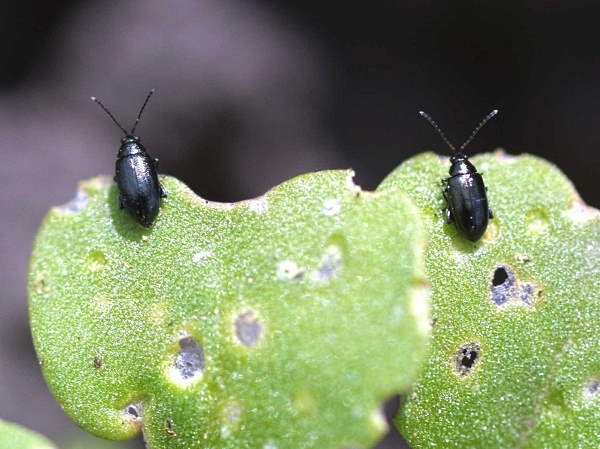

Flea traps
Sticky traps can help reduce the pest population on cabbage and eggplant. You can buy them in gardening stores, or do it yourself.
Bright strips of fabric are impregnated with a sticky composition. You can make sugar or honey syrup for catching insects.
A strong thread is pulled on pegs driven in at the edges of a row of vegetables, on which the shreds are attached. To increase the effectiveness of the trap, sticky strips should be placed 2 for each linear meter.
For the convenience of replacing traps, you can attach it to clothespins or paper clips. As insects accumulate, change the tissue.
Fly tape can be used in the same way. The main thing is that the surface of the trap is sticky.
How to get rid of fleas on cabbage?
When the air temperature rises to +15 degrees, a cruciferous flea appears on the cabbage, which hibernates under plant debris in the surface layers of the soil.
The flea is very harmful by damaging the leaves, which is especially dangerous at the early stage of cabbage development. If you do not take any measures, cabbage can die within a few days, especially if it is warm.
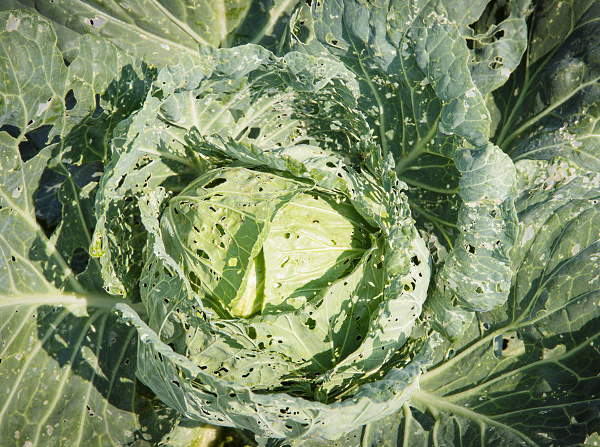

How to treat cabbage from a cruciferous flea?
Early ripe cabbage
it is better to process folk remedies, they are less toxic - spraying with vinegar every 7 days, infusion of tobacco or ash, decoction from the tops of tomatoes.
Late and medium varieties of cabbage
can be treated with chemicals -
Aktara, Decis, Actellik, Karate
.
After a few treatments, you will completely get rid of the cruciferous flea.
Treatment of cabbage from fleas with biological preparations
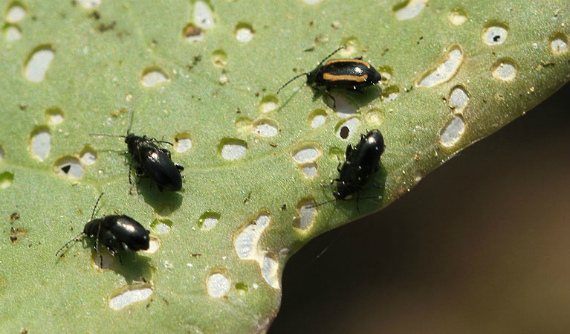

To protect garden crops from harmful insects, biological insecticides have been developed that do not harm beneficial living creatures and do not accumulate in plant tissues.
Fitoverm and Aktofit are used against cruciferous fleas.
Aktofit is a yellow liquid. The active ingredient is aversectin, which paralyzes the nervous system of the pest. The drug can be used without time limits, including during the harvest period. Analogs of Aktofit are: Akarin, Nisoran, Mitak, Confidor.
Cabbage is treated with the drug several times a season, achieving complete destruction of insects. The dosage of the drug is 6 ml per 1 liter of water.
Fitoverm is a preparation based on soil fungi.Its action is similar to that of Aktofit, penetrating into the intestinal tract of an insect, the substance has a paralyzing effect, the pest dies.
Fitoverm “works” for 2-3 weeks, after which the treatment can be repeated. The dosage of the preparation for cabbage is 4 ml per 1 liter of water. Plants are sprayed abundantly, trying to get the solution on the leaves and on the underside.
Cruciferous flea beetle chemicals
Most often, insecticides are used to combat the flea.
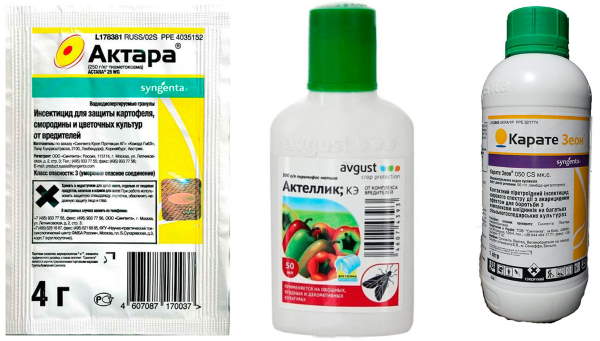

Aktara
- a systemic insecticide of contact-intestinal action against many types of pests, sucking and hidden living.
Decis
- effectively destroys Lepidoptera, Homoptera, Coleoptera pests.
Bankcol
- insecticide against leaf-gnawing and sucking pests.
Actellic
- non-systemic insectoacarecide for combating leaf-eating and sucking insects pests.
Karate
- combined insecticide against sucking and gnawing pests.
Also, in the fight against cruciferous flea, you can use drugs such as Mospilan, Fitoverm, Inta-Vir
.
Folk remedies for combating cruciferous flea
To process vegetable crops from cruciferous flea beetles with chemical preparations should be done only in extreme cases, because they are dangerous to humans.
It is better to use time-tested folk remedies.
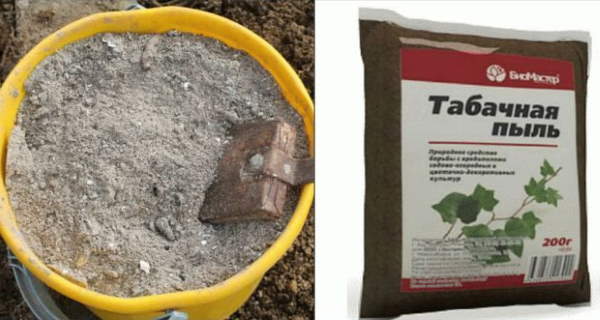

The planted seedlings must be powdered wood ash
or
a mixture of ash with tobacco dust
(ready-made drug Tabazol is sold). This is done in dry weather, repeating the treatment every 5 days 3 times.
A decoction of tomato tops
- 4 kg of fresh tops are crushed and poured with 10 liters of water for 4 hours. After a lapse of time, boil for 30 minutes, cool and strain. Before processing, dilute the broth with water 1: 1 by adding 40 grams of grated soap. It will take 3 such treatments with a break of 3-4 days.
Dandelion leaves and roots
- chop 500 g of roots and leaves, dilute with 10 liters of water. Strain and add soap to stick.
Wood ash
- Insist 2 glasses of ash in 10 liters of water for 2 days. Carefully drain the water and add the 4th part of the grated bar of soap to spray the plants.
Vinegar
- pour a glass of 9% vinegar into a bucket of water, stir and spray over the leaves.
Sagebrush
- chop 1 kg of wormwood, add 2 liters of water, boil for 15 minutes. Cool the broth, add 100 g of chopped garlic, strain. Bring the amount of broth to 10 liters and spray the plants.
Shampoo
- dilute 2 tablespoons of flea shampoo from a pet store in 10 liters of water, spray.
Preventive treatment for cabbage flea beetles
It is better to prevent the appearance of a cabbage flea on the site than to deal with them. To do this, it is necessary to carry out a number of activities that will help to avoid the appearance of fleas.
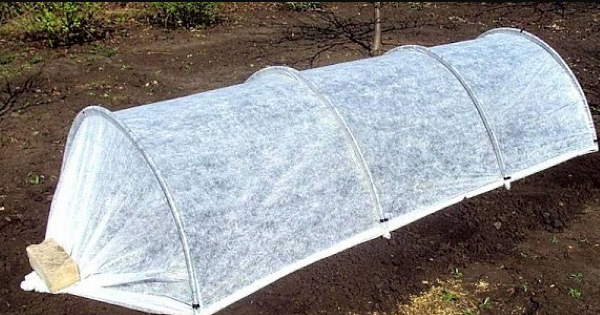

The planted seedlings can be immediately cover with nonwoven fabric
, after the leaves have roughened, the material can be removed.
Plant next to cabbage garlic, coriander, dill
- the smell of these plants scares off the flea.
Spread out every day in cruciferous aisles bunches of wormwood
.
Add fragrant to the water for irrigation. fir or pine oil
, valerian tincture 10-15 drops per 10 liters of water.
Remove weeds
in a timely manner, fleas can settle on them.
Plant seedlings in the ground until the flea is still active.
Aphid
Aphids eat the leaves and suck out all the sap from the plants. It can appear even in well-protected ground. Therefore, every gardener must prepare for a meeting with this pest. They are more harmful than eggplant mites or fleas.
In one season, aphids will be able to give more than twenty generations. And each individual eats the plant next to which she was born. Insect-infested eggplants look like they've been overcome by disease. The ovaries begin to fall off, and the leaves begin to curl. This effect is given by aphids after their appearance.Fleas bring similar troubles. But they usually only infect the leaves, not the whole plant.
Aphids on eggplant settle at the bottom of the leaf
Aphids will disappear from the site if the gardener uses the following measures to eliminate it. They can also be used if fleas are bred in the beds. So let's look at how to deal with aphids?
- Before planting work, it is imperative to clear the area of old plants and weeds on which aphids can settle.
- Affected leaves must be removed manually, thereby preventing a new generation of pests that eat the plant from being born.
- An infusion of potato tops, tobacco dust and onion skins has a good effect.
- As with other pests, aphids can be controlled with special chemicals such as Fitoverm and Akarin.
Biological product Fitoverm is effective against aphids and spider mites
Aphids are very noticeable in the area. It infects the leaves, lays the larvae under them. Measures should be taken immediately to eliminate the pest before serious diseases begin to appear due to it.

